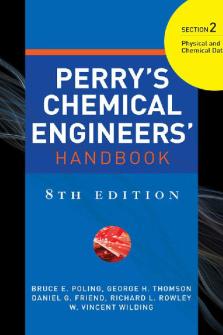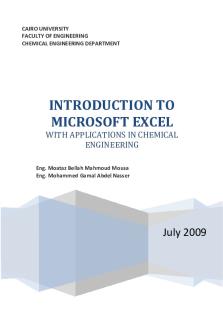Rules of Thumb for Chemical Engineers - Carl Branan - 3rd PDF

| Title | Rules of Thumb for Chemical Engineers - Carl Branan - 3rd |
|---|---|
| Pages | 443 |
| File Size | 32.5 MB |
| File Type | |
| Total Downloads | 192 |
| Total Views | 483 |
Summary
l V 3 N O I L L I ~ H I Rules of Thumb for Chemical Engineers RULES OF THUMB FOR CHEMICAL ENGINEERS A manual of quick, accurate solutions to everyday process engineering problems Third Edition Carl R. Branan, Editor Gulf Professional Publishing an imprint of Elsevier Science Amsterdam London New Yor...
Description
Accelerat ing t he world's research.
Rules of Thumb for Chemical Engineers - Carl Branan - 3rd Luis Ángel Sánchez Madera
Related papers
Download a PDF Pack of t he best relat ed papers
l V 3 N
O
I
L
L
I
~
zy H
I
Rules of Thumb for Chemical Engineers
RULES OF THUMB FOR CHEMICAL ENGINEERS A manual of quick, accurate solutions to everyday process engineering problems
zy
Third Edition
Carl R. Branan, Editor
Gulf Professional Publishing an imprint of Elsevier Science
zyxw
Amsterdam London New York Oxford Paris Tokyo Boston San Diego San Francisco Singapore Sydney
zyxwvutsrqpo zyxwvutsr
To my five grandchildren: Katherine, Alex, Richard, Matthew and Joseph
Gulf Professional Publishing is an imprint of Elsevier. Copyright by Elsevier (US.4). All rights reserved. Originally published by Gulf Publishing Company, Houston, TX
No part of this publication ma!; be reproduced, stored in a retrieval system, or transmitted in any form or by any means, electronic. mechanical, photocopying, recording, or otherwise, without the prior written permission of the publisher.
,--.
Permissions may be sought directly from Elsevier's Science & Technology Rights Department in Osford, UK: phone: (+44) 1865 843830, fax: (+44) 1865 853333, e-mail: permissions~,elsei,ier.co.uk. You may also complete your request on-line via the Elsevier Science homepage (http://uww.elsevier.com), by selecting 'Customer Support' and then 'Obtaining Permissions'.
E' This book is printed on acid-free paper. Library of Congress Cataloging-in-Publication Data Rules of thumb for chemical engineers: a manual of quick, accurate solutions to eievday process engineering problernsiCar1R. Branan, editor.-3Id ed. p. cm. Includes index. ISBN 0-7506-7567-5 (pbk.: akpaper) 1. Chemical engineering-Handbooks, manuals, etc. I. Branan, Carl. TPl5l.R85 2002 660-dc2 1
zyxwvutsr
2002071157 British Library Cataloguing-in-Publication Data A catalogue record for this book is available from the British LibrarJ..
The publisher offers special discounts on bulk orders of this book. For information, please contact: Manager of Special Sales Elsevier Science 200 Wheeler Road Burlington, MA 01803 Tel: 781-3 13-4700 Fax: 781-313-4802 For information on all Gulf publications available, contact our World Wide Web homepage at httD:!'i\nr.lv.bh.com:vuIf
zyxwvutsrqponm
10 9 8 7 6 5 4 3 2 Printed in the United States of America.
zyxwvutsrqpo zyxwvutsrq zyxwvutsrq zyxwvu 3: Fractionators. 49
S E C T I O N ONE
Equipment Design 1: Fluid Flow. 2
Velocity head ............................................................ Piping pressure drop .................................................. Equivalent length ...................................................... Recommended velocities .......................................... Two-phase flow ........................................................ Compressible flow .................................................... Sonic velocity ......................................................... Metering ................................................................. Control valves ........................................................ Safety relief valves .................................................
1
Introduction ............................................................ 50 Relative volatility ................................................... 50 Minimum reflux...................................................... 51 Minimum stages ..................................................... 52 Actual reflux and actual theoretical stages ............52 Reflux to feed ratio ................................................ 53 Actual trays ............................................................ 54 Graphical methods .................................................. 54 .. Tray efficiency .......................................................... Diameter of bubble cap trays ................................. 59 Diameter of sieve/valve trays (F factorj ................60 Diameter of sievehralve trays (Smith) ...................61 Diameter of sievehlve trays (Lieberman) ...........63 Diameter of ballast trays ........................................ 63 Diameter of fractionators. general ......................... 65 Control schemes ..................................................... 65 Optimization techniques ......................................... 69 Reboilers ................................................................. 72 Packed columns ...................................................... 76
3
4 5 7 9 12 12 13 16
2: Heat Exchangers. 19
4: Absorbers. 97
TEMA ..................................................................... 20 Selection guides ...................................................... 24 Pressure drop shell and tube .................................. 27 Temperature difference ........................................... 29 Shell diameter ......................................................... 30 Shellside velocity maximum .................................. 30 Nozzle velocity maximum ..................................... 3 1 Heat transfer coefficients ........................................ 3 1 Fouling resistances ................................................. 38 Metal resistances .................................................... 40 Vacuuni condensers ................................................ 42 Air-cooled heat exchangers: forced vs induced draft ....................................................... 42 Air-cooled heat exchangers: psessure drop air side ................................................................ 43 Air-cooled heat exchangers: rough rating ..............44 Air-cooled heat exchangers: temperature control ................................................................. 46 Miscellaneous rules of thumb ................................ 48
Introduction ............................................................ 98 Hydrocarbon absorber design ................................ 98 Hydrocarbon absorbers . optimization ..................100 Inorganic type ....................................................... 101
5: Pumps. 104 Affinity laws ......................................................... 105 Horsepower........................................................... 105 Efficienc................................................................ 105 Minimum fl0.c. ...................................................... 105 General suction system ........................................ 106 Suction system NPSH available .......................... 107 Suction system NPSH for studies ........................ 108 Suction system NPSH with dissolved gas ...........109 Larger impeller ..................................................... 109 Construction materials .......................................... 109 V
vi
Contents
6: Compressors. 112
zyxwvutsr zyxwvutsr
Ranges of application ........................................... Generalized Z ....................................................... Generalized K ....................................................... Horsepower calculation ........................................ Efficiencp .............................................................. Temperature rise ................................................... Surge controls .......................................................
113 113 114 115 119 121 121
7: Drivers. 122 Motors: efficiency................................................. Motors: starter sizes ............................................. Motors: service factor .......................................... Motors: useful equations ...................................... Motors: relative costs ........................................... Motors: overloading ............................................. Steam turbines: steam rate ................................... Steam turbines: efficiency .................................... Gas turbines: fuel rates ......................................... Gas engines: fuel rates ......................................... Gas expanders: available energy ..........................
123 124 124 125 125 126 126 126 127 129 129
8: SeparatorslAccumulators. 130 Liquid residence time ........................................... Vapor residence time ............................................ VaporAiquid calculation method .......................... LiquidAiquid calculation method ......................... Pressure drop ........................................................ Vessel thickness .................................................... Gas scrubbers ....................................................... Reflux drums ........................................................ General vessel design tips ....................................
131 132 133 135 135 136 136 136 137
9: Boilers. 138 Power plants ......................................................... Controls ................................................................ Thermal efficiency ................................................ Stack gas enthalpy ................................................ Stack gas quantity ................................................ Steam drum stability ............................................ Deaerator venting ................................................. Water alkalinity .................................................... Blowdown control ................................................
139 139 140 141 142 143 144 145 145
Impurities in water ............................................... 145 Conductivity versus dissolved solids ................... 147 Silica in steam ...................................................... 148 Caustic embrittlement .......................................... 148 Waste heat ............................................................. 150
10: Cooling Towers. 153 System balances ................................................... 154 Temperature data .................................................. 154 Performance .......................................................... 156 Performance estimate: a cast history ...................158 Transfer units ........................................................ 158
SECTION TWO
Process Design
161
11: Refrigeration. 162 Types of systems .................................................. 163 Estimating horsepower per ton ............................ 163 Horsepower and condenser duty for specific refrigerants ........................................................ 164 Refrigerant replacements...................................... 182 Ethylene/propylene cascaded system ................... 183 Steam jet type utilities requirements .................... 183 Ammonia absorption type utilities requirements ..................................................... 186
12: Gas Treating. 187 Introduction .......................................................... Gas treating processes .......................................... Reaction type gas treating .................................... Physical solvent gas treating ................................ PhysicaVchemical type ......................................... Carbonate type ...................................................... Solution batch type ............................................... Bed batch type ......................................................
188 188 190 191 191 192 192
193
13: ~aCUUmsystems. 194 Vacuum jets .......................................................... Typical jet systems ............................................... Steam supply ........................................................
195 196 197
zy zyxwvutsr
Measuring air leakage .......................................... Time to evacuate .................................................. Design recommendations ..................................... Ejector specification sheet ....................................
198 198 199 200
14: Pneumatic Conveying. 202 Types of systems .................................................. Differential pressures ........................................... .. Equipment sizing ..................................................
203 204 204
15: Blending. 206 Single-stage mixers .............................................. 207 Multistage mixers ................................................. 207 Gadliquid contacting ............................................ 208 Liquid/liquid mixing ............................................ 208 Liquidkolid mixing .............................................. 208 Mixer applications ................................................ 209 Shrouded blending nozzle .................................... 210 Vapor formation rate for tank filling .................... 210
SECTION THREE
Plant Design
211
16: Process Evaluation. 212 Introduction .......................................................... Study definition .................................................... Process definition ................................................. Battery limits specifications ................................. Offsite specifications ............................................ Capital investments .............................................. Operating costs ..................................................... Economics ............................................................ Financing ..............................................................
2 13 2 13 2 15 222 226 230 237 240 244
67: Reliability. 247 18: Metallurgy. 249 Embrittlement ........................................................ 250 Stress-corrosion cracking ..................................... 256 Hydrogen attack ................................................... 257 Pitting corrosion ................................................... 259
Contents
vii
Creep and creep-rupture life ................................ Metal dusting ........................................................ Naphthenic acid corrosion ................................... Fuel ash corrosion ................................................ Thermal fatigue .................................................... Abrasive wear ....................................................... Pipeline toughness ................................................ Common corrosion mistakes ................................
260 262 264 265 267 269 270 271
19: Safety. 272 Estimating LEL and flash ..................................... 273 Tank blanketing .................................................... 273 Equipment purging ............................................... 275 Static charge from fluid flow ............................... 276 Mixture flammability............................................ 279 Relief manifolds ................................................... 282 Natural ventilation ................................................ 288
20: Controls. 289 Introduction .......................................................... 290 Extra capacity for process control ....................... 290 Controller limitations .......................................... 291 False economy ...................................................... 292 Definitions of control modes ................................ 292 Control mode comparisons .................................. 292 Control mode vs application ................................ 292 Pneumatic vs electronic controls ......................... 293 Process chromatographs ....................................... 294
SECTION FOUR
Operations
285
21:Troubleshooting. 296 Introduction .......................................................... 297 Fractionation: initial checklists ............................ 297 Fractionation: Troubleshooting checklist .............299 Fractionation: operating problems ....................... 301 Fractionation: mechanical problems .................... 307 Fractionation: Getting ready for troubleshooting ................................................. 311 Fractionation: “Normal” parameters .................... 312
viii
zyxwvutsrqpo zyxwvutsrq
Contents
Fluid flow ............................................................. Refrigeration ......................................................... Firetube heaters .................................................... Safety relief valves ............................................... Gas treating .......................................................... Compressors ......................................................... Measurement ........................................................
313 316 317 318 319 323 325
Autoignition temperature ..................................... Gibbs free energy of formation ............................ New refrigerants ...................................................
371 376 386
26: Approximate Conversion Factors. 387 Approximate conversion factors ..........................
388
22: Startup. 326 Introduction .......................................................... 327 Settings for controls ............................................. 327 Probable causes of trouble in controls .................328 Checklists ............................................................. 330
23: Energy Conservation. 334 Target excess oxygen ........................................... Stack heat loss ...................................................... Stack gas dew point ............................................. Equivalent fuel values .......................................... Heat recovery systems ......................................... Process efficiency ................................................. Steam traps ........................................................... Gas expanders ...................................................... Fractionation ......................................................... Insulating materials ..............................................
335 336 336 338 339 340 341 343 344 344
346
25: Properties. 351 Introduction .......................................................... Approximate physical properties ......................... Viscosity ............................................................... Relative humidity ................................................. Surface tension ..................................................... Gas diffusion coefficients ..................................... Water and hydrocar~ons....................................... Natural gas hydrate temperature .......................... Inorganic gases in petroleum ............................... Foam density ........................................................ EquiITalent diameter ..............................................
389
Appendix 1: Shortcut Equipment Design Methods.0verview. 390 Appendix 2: Geographic Information Systems. 392
24: Process Modeling Using Linear Programming. 345 Process modeling using linear programming ....................................................
Appendixes
352 352 353 357 358 358 360...
Similar Free PDFs

Bsria BG09 Rules of Thumb 5th Edtn
- 101 Pages

Perry's Chemical Engineers
- 521 Pages

geology for civil engineers
- 4 Pages

Differential equations for engineers
- 242 Pages

Matrix algebra for engineers
- 187 Pages
Popular Institutions
- Tinajero National High School - Annex
- Politeknik Caltex Riau
- Yokohama City University
- SGT University
- University of Al-Qadisiyah
- Divine Word College of Vigan
- Techniek College Rotterdam
- Universidade de Santiago
- Universiti Teknologi MARA Cawangan Johor Kampus Pasir Gudang
- Poltekkes Kemenkes Yogyakarta
- Baguio City National High School
- Colegio san marcos
- preparatoria uno
- Centro de Bachillerato Tecnológico Industrial y de Servicios No. 107
- Dalian Maritime University
- Quang Trung Secondary School
- Colegio Tecnológico en Informática
- Corporación Regional de Educación Superior
- Grupo CEDVA
- Dar Al Uloom University
- Centro de Estudios Preuniversitarios de la Universidad Nacional de Ingeniería
- 上智大学
- Aakash International School, Nuna Majara
- San Felipe Neri Catholic School
- Kang Chiao International School - New Taipei City
- Misamis Occidental National High School
- Institución Educativa Escuela Normal Juan Ladrilleros
- Kolehiyo ng Pantukan
- Batanes State College
- Instituto Continental
- Sekolah Menengah Kejuruan Kesehatan Kaltara (Tarakan)
- Colegio de La Inmaculada Concepcion - Cebu










